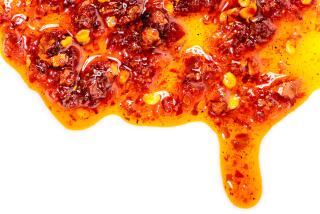Fruit Fight : New Zealand Is Angry Over U.S. Charges It Is ‘Dumping’ Kiwi Fruit
- Share via
In the 1980s, American magazine and newspaper readers were bombarded with recipes for the likes of kiwi cheesecake, kiwi pasta salad, salsa chicken with kiwi and all sorts of other fanciful dishes.
California farmers and rival New Zealanders inspired this spurt of culinary creativity to pump up a U.S. market for the small, brown, furry fruit, grown in New Zealand for decades but for many years virtually unknown here.
They succeeded. Kiwis became the in fruit of the ‘80s. Last year, U.S. sales of the fruit with the bright-green pulp and the strawberry-like taste topped $140 million, and the American market is the world’s fastest growing. But this tale of transpacific cooperation does not yet have a happy ending.
It seems that California farmers believe that the New Zealanders grew greedy and tried to grab a greater share of the U.S. market by underpricing their kiwis here. From the South Pacific come cries of betrayal in response to the “dumping” charge the Californians filed with the U.S. Department of Commerce last April. The New Zealanders deny unfair pricing and are especially bitter because they helped some of the state’s pioneer growers get a start in the business and contributed key financial support toward promoting kiwis when it appeared that the fruit would remain a weak-selling novelty.
A U.S. government trade commission has issued a preliminary finding that American kiwi growers were hurt financially by the pricing and marketing activities of their New Zealand competitors. But to find the New Zealanders guilty of dumping, the U.S. Commerce Department must conclude that their pricing and marketing practices in the United States were inconsistent with practices in other markets.
The Commerce Department is expected to announce its findings today. If found guilty of dumping, New Zealanders will have to pay anti-dumping duties on their exports to the United States. New Zealand exports about 90% of its crop, 12% to the United States. On the other hand, worldwide exports account for only 10% of U.S.-grown kiwis--99% of which is grown in California.
Because American kiwi farmers depend so much on U.S. sales, many New Zealanders suspect that “U.S. growers are using the anti-dumping laws for protectionist reasons,” says Hillary Brick, the Vancouver-based director of the New Zealand Kiwifruit Marketing Board’s North American operations.
“American kiwi fruit is short of the quality of New Zealand’s. We’re not to blame. California growers have had difficulties because their management techniques are not as strong as New Zealand’s and because their operations have suffered during the drought, which has put stress on their (kiwi) vines,” Brick adds.
However, Mark Houston, director of the Sacramento-based California Kiwifruit Commission, contends that U.S. growers have lost about 25% of the American market since 1988 because of unfair competition from New Zealand. (The commission’s most recent statistics show that U.S. growers have 39% of the American market, compared to New Zealand’s 60%. But New Zealand says each side has nearly equal market share.) California growers are simply trying to get the Commerce Department to eliminate a trade practice that other governments would not tolerate, Houston said.
“New Zealand growers have been dumping here because they believed that North America was the path of least resistance--that they could get away with it,” Houston said. “In this situation, the purpose of the (anti-dumping) law is to keep a big producer from forcing California farmers out of the business. New Zealand’s arrogance has led us to this point.”
Gary Suthers, a Kern County kiwi grower, says he lost $250,000 in sales in 1990 and 1991 because a glut of New Zealand fruit depressed U.S. market prices. “They nearly broke the back of the market,” he says.
There has been little head-to-head competition between New Zealand and California kiwi growers because of different growing seasons. California distributes kiwis from October through May and New Zealand has traditionally sold its fruit from May through December.
However, California growers contend that the New Zealanders have been extending their marketing season into January and February during the last three years, undercutting California. New Zealand’s marketing board says it extended its marketing season in the United States for only two months last year, when Japanese importers rejected a shipload of kiwis.
“We diverted one shipment from Japan to the United States and that was a mistake and an aberration,” said Brick. “But there was no three-year (dumping) pattern. These charges are unfair to an industry that developed worldwide demand for kiwis.”
New Zealand first exported the fruit--originally known as the Chinese gooseberry because it originated in China--to the United States in 1959. The New Zealanders renamed the fruit after their national bird to eliminate any possible association with the communist Chinese government during that period.
Seeking to expand export markets for its agricultural industries, New Zealand introduced the fruit around the world. It teamed up with U.S. growers to promote the fruit in the 1980s after separate marketing efforts in the 1970s failed to generate much enthusiasm for the product.
Consider the experience of George Tanimoto, a peach-grower in the Sacramento Valley community of Gridley who produced America’s first commercial harvest of kiwis in 1970. He said he had difficulty in the 1970s getting Americans to distinguish the name of his fruit from a brand of shoe polish called “Kiwi.”
Now that a viable market has been established, New Zealanders say U.S. consumers will pay higher prices and the fruit will become less available if it gets a negative ruling from U.S. officials. Moreover, Brick said, the New Zealand Kiwifruit Marketing Board would not be able to afford its planned 1992 $1-million advertising campaign designed to increased overall kiwi sales. “This is a possible tragedy because dumping penalties will stymie the overall growth of this business,” she said.
California farmers say the future of a U.S. growth industry and American jobs are at stake in the dispute. About 4,500 full- and part-time workers are employed by California kiwi growers.
Houston says he believes that others--Chilean kiwi farmers, for example--are prepared to further promote U.S. kiwi sales should the New Zealanders reduce their marketing and sales efforts.
“Others are waiting to take up any slack,” Houston said. “For California growers, this dispute is a matter of survival.”
A Growing Taste for Kiwis
Kiwi growers in California and New Zealand have helped stimulate a sharp increase in American consumption of the fruit by launching cooperative and complementary promotional campaigns. However, the two kiwi-growing communities are now at odds as the fruit reaches new levels of popularity. The chart shows annual American consumption of kiwifruit.
More to Read
Inside the business of entertainment
The Wide Shot brings you news, analysis and insights on everything from streaming wars to production — and what it all means for the future.
You may occasionally receive promotional content from the Los Angeles Times.










